A world of bacteria
I warn you as of now: if you are rupophobic, that is, if you have an obsession with cleanliness and hygiene, do not read this article. I take no responsibility if you do. If yours is not a phobia but you are anyway an avid consumer of antibacterial or antimicrobial products and prefer to buy soaps and detergents when they have these characteristics, perhaps reading this article may turn out to be useful.
Microorganisms and similar
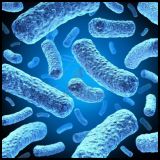
First of all let us do some clarity regarding the terminology. A bacterium is a single-celled prokaryotic organism, that is, it lacks membrane, organelles, or other internal subdivisions. The DNA of a prokaryotic organism is then immersed within the cytoplasm, that combination of organic and inorganic chemicals contained within the borders of the plasma membrane, the “skin” of the microorganism. In fact the prokaryotes are divided into two major families: Archæa and Bacteria. Often the term bacteria has been misused for archaea too.
The term microbe is used instead as a synonym of microorganism, without specifying whether prokaryotic or eukaryotic, that is, with the DNA protected by a nucleus. In fact, a microbe can also be multicellular; an example are some protozoa. The only condition that defines a microbe as such is therefore the size, that is, it must be less than a tenth of a millimeter. The bacteria, however, are large from 0.2 to 300 µm, where a micrometer (1µm) is a thousandth of a millimeter. So while the term bacterium defines in fact one of the two kingdoms in the domain of prokaryotes, the term microbe does not have any scientific or taxonomic meaning but is intended to classify organisms based on size.
In fact, often the term microbe is also used for viruses, viroids, and prions, which are not considered true organisms but simple molecules protected by lipoproteins: DNA for viruses, RNA for viroids, and a glycoprotein for prions. For the record, the other five kingdoms in the domain of eukaryotes are Protista, Chromista, Fungi, Plantæ, and Animalia.
Biosphere
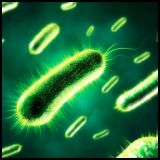
Today we know that the biosphere, that is, that part of the Earth that enables the development and maintenance of life, is far more extensive than we thought in the past: more than 10 kilometers below the Earth’s surface to more than 65 km above it, right into the stratosphere. In particular, it was recently discovered that in the troposphere, that is, at an altitude between 8 and 15 km, there is a large number of microorganisms. Researchers have recently found as many as 17 different groups of bacteria in the upper atmosphere, many of which are estimated to be living permanently in that range. In addition, there are those who are often raised from the ground by the wind to several kilometers in altitude.
Other microorganisms, especially bacteria and archaea, live instead in the depths of the Earth. They have been found in nearly twelve kilometers deep inside the rocks that form the Earth’s crust. It is estimated that the mass of the bacteria of the subsoil is probably equivalent to 2×1014 tons. In practice, if we would amass all of them over the dry land, they would form a uniform layer as much as a meter and a half, a quantity of biomass well above that of the flora and fauna existing on the surface.
Human Microbiota
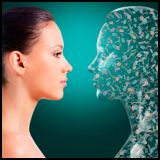
The body of young male adult, average height and about 70 kg weight, is made up of approximately 100 trillion (1014) of cells. Well, it is estimated that the number of microorganisms, mostly bacteria, present on the surface and inside our body be over 10 times that value, that is, a million billion (1015) of microbes. Just on the skin, including viruses, bacteria, and fungi, they are over one million (1012) divided into more than 1,000 species belonging to 19 different phyla. However, someone found well over 100,000 different gene sequences on a standard sample of human skin.
Most of the microorganisms that live inside and outside of the human body are not pathogenic, but commensals — that is completely harmless but of no use — or mutualists — that is symbiotic organisms, designed to provide mutual benefits with host. Often one of these benefits, in the case of cutaneous microbiota, is to prevent pathogenic germs from attacking and colonizing the human skin.
In the human intestine live about 400 bacterial species, both anaerobic (bifidobacteria), located mainly in the colon, and aerobic (lactobacilli), concentrated especially in the small intestine, as well as fungi, viruses, and clostridia, which have no pathogenic effect under normal conditions.
Among the many benefits of what is improperly called intestinal flora there are: the trophic function, the one that guarantees the integrity of the intestinal mucosa; the anti-pathogenic protective function, which further enhances the barrier effect of the intestinal mucosa producing antimicrobial substances; the digestive function, which promotes digestion and absorption; the metabolic function, which produces some vitamins, primarily vitamin B12 and K, as well as certain amino acids (arginine, glutamine, cysteine).
Therefore the human microbiota is not only a guest which is useful to the functioning of certain physiological processes, but it is essential for those processes, that is, we can say to all effects that a human being is not a multicellular organism but rather a multiorganic complex.
Antibacterial substances
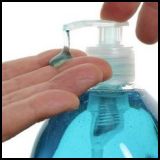
Antibacterial substances can be of two types: bacteriostatic, that is, that inhibit bacterial growth, or bactericidal, that is, designed to kill bacteria. Most of these substances are not able to distinguish between pathogenic, commensalistic, and mutualistic microorganisms, so that an excessive use of these substances may damage that part of the human microbiota that does not harm us in any way and also that part that we need or is even essential to our health.
Washing too often your hands and using too often antibacterial substances on our body or the environment that surrounds us, then, can be counterproductive: washing too frequently, in fact, weaken the body’s natural defenses. Obviously, in the case of wounds, bruises, or cuts, the capacity to protect the skin may fail and the microorganisms already present on the epidermis or coming from the environment can give rise to infections. That’s why you have to disinfect wounds.
Hygiene of the house
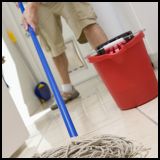
Thinking of transforming the house where we live in a sterile environment is, however, not only objectively impractical but conceptually wrong. In general, the areas of the house and the objects with a higher degree of humidity, such as bathrooms, kitchen, toilets, towels, and dish towels, are usually contaminated with bacteria with which we live in daily contact. Our immune system is, however, perfectly able to defend against any pathogen, unless it suffers from immunodeficiency diseases.
On the other hand, the environment that surrounds us is the one in which we naturally evolved. If it be quite hostile, we would probably be already extinct. If we consider that throughout most of human history we lived in a much more septic and much less hygienic environment than that in which a part of the human population lives today, especially that part that cares more about the use of certain substances, it is clear that this kind of concerns are a tad excessive.
Thence, there is no need to spread everywhere antibacterial substances in the house: in fact it is enough to adopt basic hygienic prophylaxis, that is, keeping the house clean and removing dirt and encrustations where pathogenic germs might lurk. In particular, the environmental disinfectants, namely those to spray in the air, are useless since their formula is originally very underdosed with respect to any possible need.
Disinfection of rooms

As regards the disinfection of rooms and objects, one of the most used substances is the sodium hypochlorite (NaCIO), available on the market in concentrations that may vary between 1% and 15%. If the concentration exceeds 5%, the product is irritating; more than 10% is corrosive; so it should not be used on the skin or wounds. At concentrations ranging between 3% and 5% it is named bleach, while under the 1.5% it is called Amuchina in some country. A more stable and solid source of active chlorine is the isocyanurate, also used in the disinfection of rooms, bathroom fixtures, and other objects.
Another family of disinfecting substances are quaternary ammonium compounds, particularly effective against Gram-positive bacteria and fungi, partially effective against Gram-negative bacteria and some viruses, not effective at all against mycobacteria (Gram positive) and spores. For the outdoor disinfection, however, phenolic compounds are often used, but they are, however, toxic to humans too.
A special mention is dedicated to the sodium bicarbonate (NaHCO3), used especially for washing and disinfecting fruits and vegetables.
Antiseptics
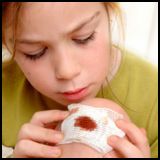
As regards the body and especially the wounds, some substances are the same used also for the environment but with a much greater degree of dilution and, obviously, a higher purity; others are different. We have several families of disinfectants: oxidants, alcohols, halogens, phenols, detergents, and biguanides.
Among the best known oxidants and one of the best in terms of effectiveness is the hydrogen peroxide which, thanks to the mechanical action of cleaning exerted by the development of oxygen gas, is able to remove dust and dirt in depth too; therefore it is particularly suitable if the wound is dirty. The action of disinfection is rather peculiar of the nature of the oxidant anyway, that is, chemical in nature.
Much less useful than you may think are the alcohols, although ethanol is effective against many bacteria, fungi and viruses, including the SARS virus. However, it is totally ineffective against spores of the bacteria. They are generally used today only to degrease and disinfect the skin before an injection.
Among the halogens, one of the best is the povidone-iodine (PVP-I). Iodine is also particularly active against spores. Once it was also used as tincture of iodine, which is mainly used today, very diluted, for the rinsing of the mouth.
Among the detergents, the best known are the quaternary ammonium compounds, already mentioned, which, however, have the defect to become inactive in the presence of anionic surfactants, such as soaps.
Enough used is also the ichthyol, or ammonium bituminosulfonate, which however has a weakly antiseptic, anti-inflammatory, anti-irritant, and bacteriostatic action. Other common disinfectants are the boric acid, chlorhexidine, mercurochrome as well as phenolic and biguanide related compounds.
Keep in mind, however, that a bactericide is not always the best choice because there are bacteria that after death, with the disintegration of the cell, release toxins.
Conclusion
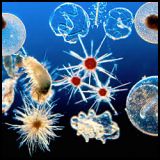
In conclusion, we live in a world in which microorganisms are dominant, to the point of being an essential component of our own body. Certainly it is important to defend us against possible pathogens, for example, by washing hands with soap before preparing food or eating; by effectively disinfecting wounds and bruises; by protecting food from flies and other insects; by keeping refrigerated perishable foods; by quickly eliminating household waste, especially the organic ones; by keeping clean the areas where we live and the objects that we use; by using with criterion antibacterial agents in certain areas of the house or on specific objects that may come into contact with mucous membranes and orifices, as in the case of bathroom fixtures.
However constantly wiping your hands with a disinfectant towelette or thinking, as some advertisement suggests, that we should have a practically sterile house in which children can play on the floor only because it has been carefully disinfected with antibacterial, is objectively exaggerated. Our immune system is perfectly capable of managing the environment in which we live, so do not let us get anxious every five minutes: we are surrounded, indeed literally covered, with bacteria and all in all it is the right thing, because they are part of our ecosystem, and without them we could not probably even exist, especially since the pathogens represent only a fraction of all existing microorganisms.




















Please use Facebook only for brief comments.
For longer comments you should use the text area at the bottom of the page.
Facebook Comments